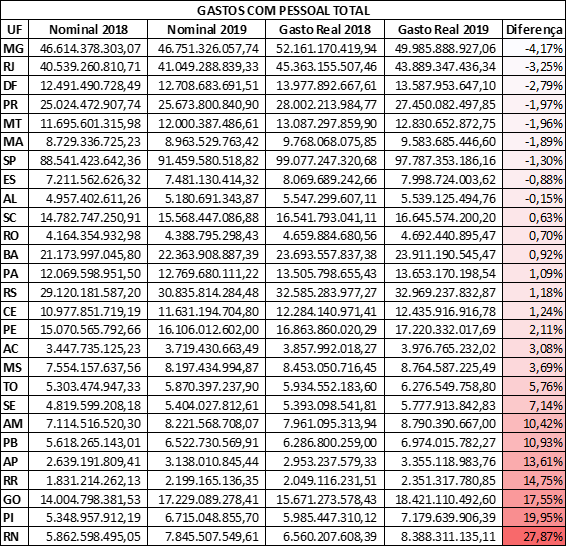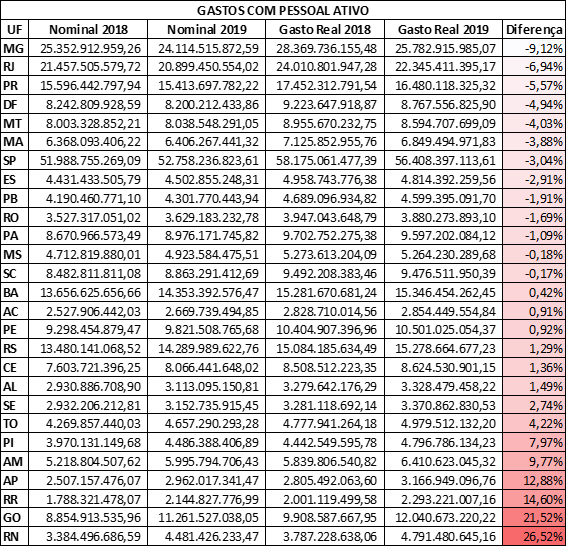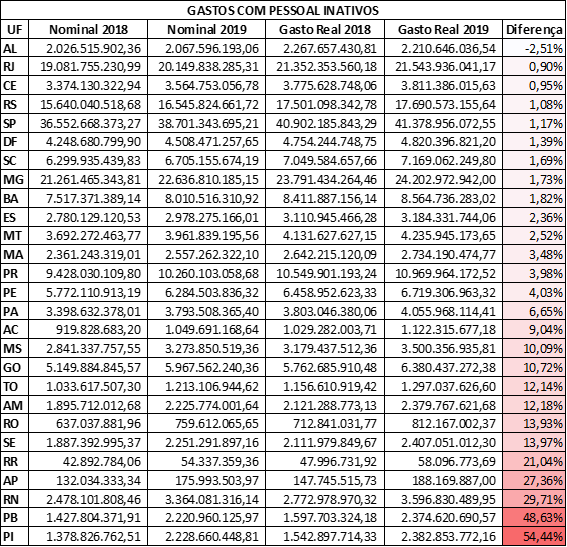During the 2018 elections, fiscal adjustment was one of the main campaign issues. Several governors were elected with the promise of cutting personnel expenses while others, on the contrary, proposed that the State should expand in times of crisis. In the field of rhetoric, anything goes, but are we going to analyze the data and understand who expanded and who contracted spending?
Through the excellent Brazilian Finance database (Finbra) available on the website of the Brazilian Public Sector Accounting and Fiscal Information System (Siconfi) [1] it is possible to compare the performance of Brazilian states in the governors' first year of work.
This post will be divided into four sections. This brief introduction, a second methodology section (I try to explain in a didactic way how I obtained the data to the lay public in Public Accounting), a third section presenting the data itself (divided by total personnel expenditure, active personnel expenditure and with inactive staff) and, finally, a conclusion.
Methodology
Personnel expenditure will be measured according to the classification of budget expenditure by nature of the Accounting Manual Applied to the Public Sector (MCASP)[2].
According to this concept, budget expenditure consists of:
a) Economic Category
b) Nature of Expense Group
c) Expense Element
The nature of expenditure is complemented by information called “Modality of Application” which aims to explain whether the resources are applied directly by the same sphere of government or not.
In addition to classifying the nature of the expense, it is also important to understand how the expense execution phases occur. According to the form provided for in Law No. 4,320/1964, it takes place through three stages: commitment, settlement and payment.
According to art. 58 of Law No. 4,320/1964, the commitment is the act emanating from a competent authority that creates for the State an obligation to pay pending or not the implementation of the condition. It is basically a reserve of a budgetary allocation for a specific purpose. Settlement consists of verifying the right acquired by the creditor based on the titles and documents proving the respective credit, that is, in settlement the Public Administration recognizes that there was a consideration for a service or purchase of an asset and the natural or legal person becomes the have the right to receive the resource from the Union. The payment phase is when the Public Administration transfers the resource to whoever owed it.
In this analysis, we will work with data on settled expenses.
total personnel expenditure , account 3.1.90.00.00 will be adopted (3.X.XX.XX — Current Expenses, X.1.XX.XX — GND Personnel and Social Charges, XX90.XX — Modality Direct Application). To measure expenses with inactive , accounts 3.1.90.01.00 (note that the numbering is the same as the previous one, but now added the Element “RPPS Retirements, Paid Reserve and Military Retirements”), 3.1.90.03.00 (Element “RPPS and Military Pensions”), 3.1.90.05.00 (Element “Other Social Security Benefits for Servants or Military Personnel”) and 3.1.90.07.00 (Element “Contributions to Closed Social Security Entities”). To measure expenses with active personnel, total personnel expenses inactive personnel expenses .
The routine created in the R language is available on my github ( https://github.com/claudiomar23/Gastos-com-pessoal-Estados )
Expenses are deflated with February 2021 prices (that is, they are presented already discounting inflation).
Results
Total personnel expenses
Firstly, total personnel expenses (3.1.90.00.00), active and inactive added together, ranked:

States, in a supposed year of fiscal adjustment, increased, on average, personnel expenses by 4.6%, already discounting inflation.
Analyzing the data presented, it is clear that there is strong regional heterogeneity. However, when analyzing the profile of governors, there is a certain ideological pattern. Among the states that cut the most personnel spending, those with governors with an ideological profile more aligned to the right stand out.

Firstly, Minas Gerais has the only governor elected by the Novo Party, Romeu Zema, who continues to fulfill one of the Party's main slogans, which is fiscal responsibility. Rio de Janeiro, Distrito Federal, Paraná and Mato Grosso, states that come next, have governors from right-wing parties (MT — Democrats) or who were elected with the support of Jair Bolsonaro (Witzel in Rio, Ibaneis in DF and Ratinho Júnior in PR). Among the states that cut the most in personnel spending, only Maranhão has as governor a politician with a left-wing ideological profile, Flávio Dino from PC do B.
Among the states that expanded spending the most, governors were more to the left.

Firstly, Rio Grande do Norte stands out, whose governor, Fátima Bezerra, was elected by the PT. Piauí, governed by the PT, and Amapá, governed by the PDT, also have governors aligned more to the left. However, it is noteworthy that Goiás and Roraima, two states with right-wing governors, are among those that showed the greatest expansion in personnel spending.
Expenses with active personnel
However, total personnel expenses say very little about the governor's management. Basically, the governor can influence and cut expenses only for active personnel (basically avoiding the granting of salary increases and new public tenders, given that dismissing employees to cut expenses is virtually impossible) considering that inactive employees and their dependents have the acquired right to receive their pensions and, even if a state pension reform is implemented, it takes a few years to take effect. Let's look at the data:

It can be seen that, as expected, the growth in percentage of assets is lower than that of total expenses. It was, on average, 2.26% already discounting inflation. This reflects that in a situation of fiscal contraction, like the current one, States have little room for expansion.
Once again, Minas Gerais continues to stand out with a strong adjustment of almost 10% discounting inflation. Among the top five, there is only one change between 3rd and 4th position, with Paraná overtaking the Federal District.

Among the expansionists, Rio Grande do Norte remains the first. However, Piauí no longer appears among the five that spent the most on personnel. The number of states governed by right-wing governors also becomes a majority.

Inactive expenses
Now let’s analyze the governors’ “Achilles heel”, the spending on inactive employees. As explained in the asset spending session, governors, as this is an acquired right, have little control over the expansion of retirement and pension spending. As expected, the States show much stronger expansions in inactive states than in active states:

Among the 27 states of the Federation, only Alagoas shows a slight decline in spending on inactive workers, with Piauí and Paraíba showing strong growth of almost 50% in spending from one year to the next. Even if a pension reform has been approved, as already explained, it will take a few years to take effect and strong growth in spending on inactive workers should be expected in the coming years.
The States showed growth of, on average, an impressive 10.91% in spending on inactive workers from one year to the next.
Final Considerations
It is possible to observe that leaving the field of rhetoric and really focusing on the data, the fiscal adjustment that was promised or criticized very little occurred in the first year of the newly elected Governors. This is due to both the almost no flexibility in spending on active personnel in times of crisis and the generous social security legislation that has been maintained for all these years and today significantly increases spending on inactive personnel in the States.
It is important to remember that this analysis involved a pre-pandemic year and 2020, when the data is available, will probably come with a strong expansion in spending on active personnel due to the need to hire health professionals to face the health case that hit Brazil. Let's wait for the data, which should be available around July.








